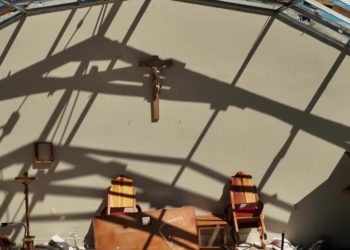Late last month, California fire officials made a courtesy call to Los Angeles.
The state’s proposed Zone Zero regulations that would force homeowners to create an ember-resistant zone around their houses — initially planned to take effect nearly three years ago — had caused an uproar in the region. It was time for damage control.
Officials from both Cal Fire and the state’s Board of Forestry and Fire Protection visited Brentwood, the epicenter of the outrage, and Altadena, where homeowners are trying to figure out how best to rebuild, but did little to assuage the concerns of the Zone Zero proposals’ most vocal critics.
The two groups took turns pointing out homes that seemed to support their claims. The copious, contradictory anecdotal evidence provided no consensus for a path forward. For example, in the Eaton burn area, officials showed residents a home they claimed was spared thanks to its removal of vegetation near the home, but residents noted a home across the street with plenty of plants that also survived.
It was an example of what’s become an interminable debate about what should be required of homeowners in L.A.’s fire-prone areas to limit the destruction of future conflagrations.
Initial attempts by the board to create Zone Zero regulations, as required by a 2020 law, quietly fizzled out after fire officials and experts struggled to agree on how to navigate a lack of authoritative evidence for what strategies actually help protect a home — and what was reasonable to ask of residents.
The Jan. 1, 2023, deadline to create the regulations came and went with little fanfare. A month after the January fires, however, Gov. Gavin Newsom signed an executive order resurrecting the efforts and ordering the board to finish the regulations by the end of the year. As the board attempted to restart and speed-run the previous efforts through a series of public meetings, many Californians grew alarmed. They felt the draft Zone Zero requirements — which would be the strictest statewide defensible space rules on the books — were a step too far.
“The science tells us it doesn’t make sense, but they’re ignoring it because they have to come up with something,” said Thelma Waxman, president of the Brentwood Homeowners Assn.,who is working to certify neighborhoods in her area as fire safe. “If I’m going to go to my members and say, ‘OK, you need to spend $5,000 doing one thing to protect your home,’ it’s not going to be to remove hydrated vegetation.”
Instead, she wishes the state would focus on home-hardening, which has much more compelling research to support its effectiveness.
Tony Andersen, the board’s executive officer, stressed that his team wants to keep requirements evidence-based and reasonable for homeowners. “We’re listening; we’re learning,” he said.
Zone Zero is one of the many fire safety regulations tied to the fire hazard severity maps created by Cal Fire, which, while imperfect, attempt to identify the areas in California likely to see intense wildfire.
Since 2008, all new homes in California in areas that those maps determined have very high fire hazard are required to have multi-paned or fire-resistant windows that are less likely to shatter in extreme heat, mesh coverings on all vents so flying embers can’t sneak inside and ignition-resistant roofing and siding.
The state’s defensible space regulations break down the areas surrounding a home into multiple zones. Zone Two is within 100 feet of the home; in that space, homeowners must remove dead vegetation, keep grass under 4 inches and ensure that there is at least 10 feet between trees. Zone One is within 30 feet of a structure; here, residents cannot store firewood. Zone Zero, within 5 feet, is supposed to be “ember-resistant” — essentially meaning that there cannot be anything that might ignite should embers land within it.
The problem is, it’s unclear how to best create an “ember-resistant” zone. For starters, there’s just not a lot of scientific evidence demonstrating which techniques effectively limit ignitions. That’s especially true for the most controversial Zone Zero proposal: removing healthy plants.
“We have very few publications looking at home losses and vegetation patterns in Zone Zero,” said Max Moritz, a wildfire-dynamics researcher with UC Santa Barbara and the UC Cooperative Extension program.
Further complicating the problem, the board also needs to consider what is reasonable to ask of homeowners. Critics of the current proposal point out that while wooden fences and outbuildings are banned, wooden decks and doors are still fine — not because they cannot burn, but because asking residents to replace them is too big of a financial burden and they are, arguably, out of the purview of “defensible space.” And while many in the L.A. area argue they should be allowed to keep plants if they’re well-watered, the board cannot single-handedly dictate water usage for ornamental vegetation across the state.
To deal with the head-spinning complexity, the state started with a small working group in 2021 that included Cal Fire staff, local fire departments and scientists. The working group slowly grew to include more local leaders and came close to finalizing the rules with the board as it neared the Legislature’s Jan. 1, 2023, deadline. But as the parties got stuck on the final details, the deadline came and went. Zone Zero slowly fell off the meeting schedules and agendas and for two years, essentially nothing was done.
Then, L.A. burned.
In February 2025, Newsom signed an executive order pushing the board to finish the regulations by Dec. 31. As the board began hosting public hearings on the regulations, shock and frustration had set in among Californians.
To add insult to injury, Newsom’s executive order also pushed Cal Fire to release new hazard maps that the Legislature had also mandated. When the agency did that in the spring, many Californians were distraught to learn that the maps added over 300,000 acres — mostly in developed areas — into the classifications where Zone Zero will apply.
At a (now somewhat infamous) Zone Zero meeting at the Pasadena Convention Center in September — the only one to take place in Southern California — public comments stretched on for over five hours. They included several speakers more accustomed to receiving public comments than making them: The mayor of Agoura Hills, representatives for L.A. City Council members and the chair of L.A.’s Community Forest Advisory Committee.
Alongside marathon public meetings, the board received more than 4,000 letters on the regulations.
In a September report to L.A.’s City Council, the Los Angeles Fire Department and the city’s forestry committee chastised the board for failing to consult the city during the process and only holding its Pasadena meeting “after persistent pressure from local advocates … six months into the rulemaking process.” It also pointed to a 2025 study that found many home-hardening techniques play a much more significant role in protecting homes than defensible space.
Most of the Zone Zero proposals have generally received agreement or at least acceptance among the public: No wooden mulch, no wooden fence that attaches to the house, no dead vegetation and only outbuildings made of noncombustible materials. But two issues quickly took center stage in the discourse: trees and plants.
Residents have become increasingly concerned with the prospect of cutting down their trees after the working group began discussing how to handle them. However, the current proposals would not require residents to remove trees.
“It’s pretty much settled,” Andersen said. Well-maintained trees will be allowed in Zone Zero; however, what a well-maintained tree looks like “still needs to be discussed.”
What to do about vegetation like shrubs, plants and grasses within the first 5 feet of homes has proved more vexing.
Some fire officials and experts argue residents should remove all vegetation in the zone, citing examples of homes burning after plants ignited. Others say the board should continue to allow well-watered vegetation in Zone Zero, pointing to counterexamples where plants seemed to block embers from reaching a home or the water stored within them seemed to reduce the intensity of a burn.
“A hydrated plant is absorbing radiant heat up until the point of ignition, and then it’s part of the progression of the fire,” said Moritz. The question is, throughout a wildly complex range of fire scenarios, when exactly is that point reached?
In October, the advisory committee crafting the regulations took a step back from its proposal to require the removal of all living vegetation in Zone Zero and signaled it would consider allowing well-maintained plants.
As the committee remains stuck in the weeds, it’s looking more and more likely that the board will miss its deadline (for the second time).
“It’s more important that we get this right rather than have a hard timeline,” Andersen said.
The post How Zone Zero, designed to protect California homes from wildfire, became plagued with controversy and delays appeared first on Los Angeles Times.




